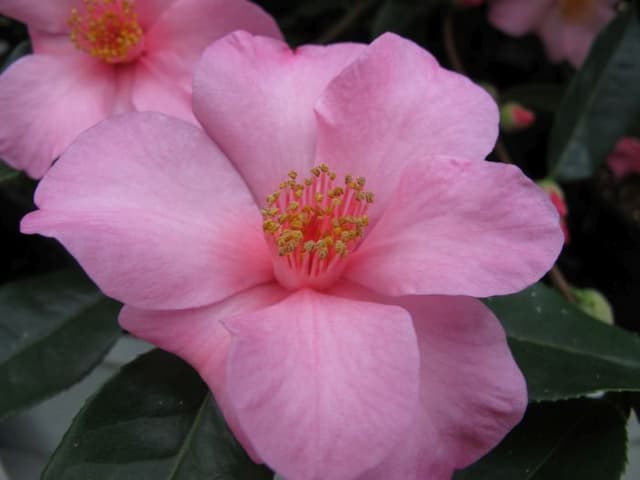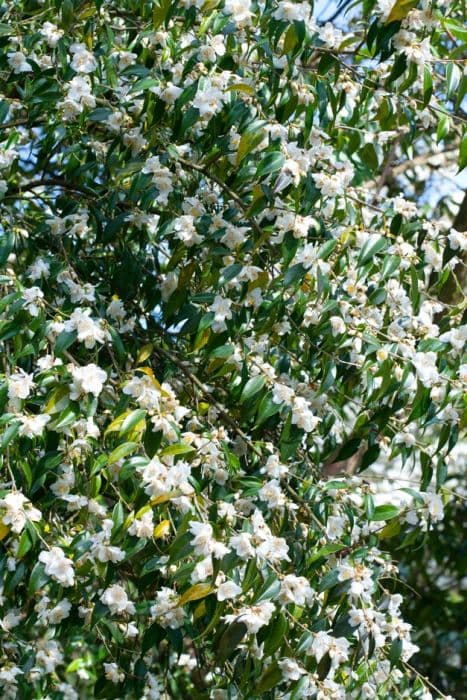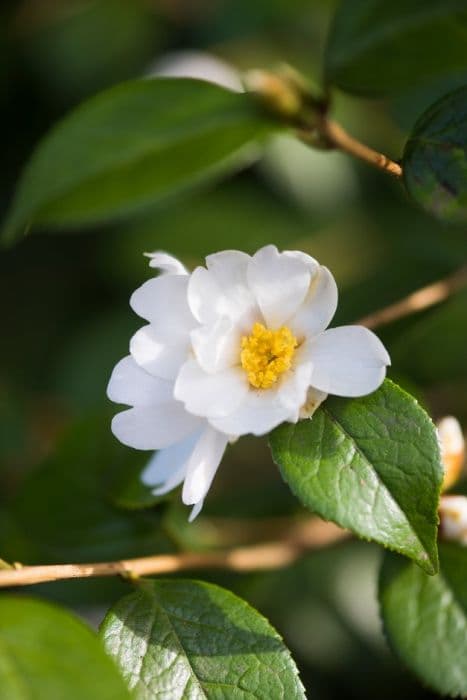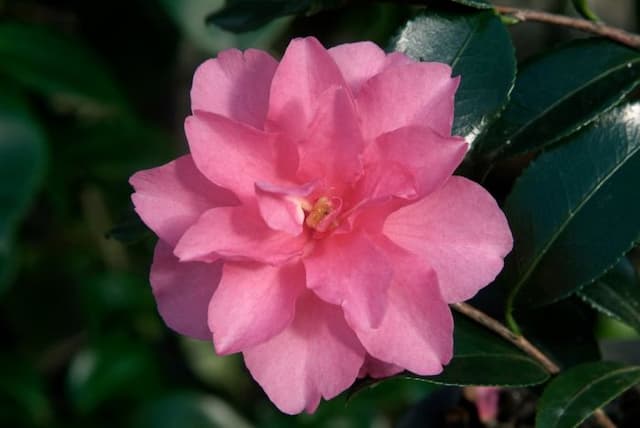Williamsii Camellia Camellia × williamsii 'Galaxie'

ABOUT
The Camellia 'Galaxie' is a visually striking plant known for its glossy, dark green leaves and the large, showy flowers that bloom from it. The leaves are typically oval-shaped with a slightly serrated edge, creating a lush and dense canopy. The flowers are the main attraction; they are generally a deep pink color, leaning towards a rosy hue, which can greatly vary in shade. Each flower is composed of multiple layers of petals, giving them a very full and ruffled appearance. The blooms are quite large, commanding attention, and are often contrasted beautifully against the dark foliage. This plant exudes elegance and is commonly appreciated for its ornamental value, bringing a splash of color and a touch of class to gardens and landscapes where it is planted.
About this plant
 Names
NamesFamily
Theaceae
Synonyms
Williamsii Camellia, Hybrid Camellia
Common names
Camellia × williamsii 'Galaxie'.
 Toxicity
ToxicityTo humans
Williamsii Camellia is generally considered non-toxic to humans. Ingesting parts of this plant is not known to cause any significant symptoms of poisoning. Therefore, accidental ingestion should not result in any serious consequences.
To pets
Williamsii Camellia is also considered non-toxic to pets. It does not contain any known toxic substances that would pose a risk to animals if they were to ingest parts of the plant. Consequently, pets ingesting this plant should not experience any harmful symptoms or serious health effects.
 Characteristics
CharacteristicsLife cycle
Perennials
Foliage type
Evergreen
Color of leaves
Green
Flower color
Pink
Height
6-8 feet (1.8-2.4 meters)
Spread
6-8 feet (1.8-2.4 meters)
Plant type
Shrub
Hardiness zones
7
Native area
Asia
Benefits
 General Benefits
General Benefits- Aesthetic Appeal: Camellia × williamsii 'Galaxie', commonly known as Williamsii camellia, boasts large and attractive flowers that enhance the visual appeal of any garden space.
- Long Flowering Period: This plant typically has a long flowering season, providing color and interest from late winter to early spring when few other plants are in bloom.
- Evergreen Foliage: The Williamsii camellia provides year-round greenery with its glossy, evergreen leaves, offering continuous structure and color even when not in flower.
- Versatility: Suitable for a variety of garden situations, including borders, specimen planting, or container gardening.
- Drought Tolerance: Once established, the Williamsii camellia can be quite tolerant of dry conditions, requiring less frequent watering than some other ornamental plants.
- Cold Resistance: It is relatively cold-hardy, making it suitable for growing in regions with cooler winter temperatures without the need for extensive winter protection.
- Pollinator Friendly: The flowers of Williamsii camellia can attract bees and other pollinating insects to the garden, supporting local ecosystems.
- Low Maintenance: Requires minimal pruning and can generally manage with natural rainfall and the occasional feed, making it an easy-care option for busy gardeners.
- Privacy and Screening: With its dense growth habit, it can be used to create privacy screens or hedges in the landscape.
- Cultural Significance: Camellias have a long history of cultivation and hold cultural significance in many parts of the world, which can add an element of heritage to a garden.
 Medical Properties
Medical PropertiesThis plant is not used for medical purposes.
 Air-purifying Qualities
Air-purifying QualitiesThis plant is not specifically known for air purifying qualities.
 Other Uses
Other Uses- Decorative potpourri: Dried flowers of Camellia × williamsii 'Galaxie' can be added to potpourri mixes for a beautiful appearance and a subtle, natural fragrance in your home.
- Natural dye: The petals of the camellia can be used to produce natural dyes for fabric, offering a range of colors from pale pinks to deep reds, depending on the processing technique.
- Culinary decoration: Edible flowers from camellias can be used to garnish salads and desserts, adding a touch of elegance to the presentation.
- Pressed flower crafts: The striking blooms can be pressed and used in crafting, such as creating bookmarks, greeting cards, or framed art.
- Floral bath soaks: Petals from the camellia can be added to bath soaks or bath bombs for a luxurious, spa-like experience at home.
- Garden photography: Due to its striking flowers, Camellia × williamsii 'Galaxie' makes an excellent subject for garden photography enthusiasts.
- Teaching tool: Camellias can be used in botanical education to demonstrate plant breeding and hybridization techniques due to their many cultivars and hybrids.
- Eco-friendly confetti: Dried petals can serve as a biodegradable alternative to traditional confetti at celebrations such as weddings.
- Flower essences: While not medically proven, some practitioners use camellias to prepare flower essences for various emotional healing approaches.
- Candle embedding: The petals can be incorporated into the wax of homemade candles to add visual appeal and a subtle fragrance when the wax melts.
Interesting Facts
 Feng Shui
Feng ShuiThe Williamsii Camellia is not used in Feng Shui practice.
 Zodiac Sign Compitability
Zodiac Sign CompitabilityThe Williamsii Camellia is not used in astrology practice.
 Plant Symbolism
Plant Symbolism- Adoration: Camellias are traditionally associated with admiration and deep affection, making them a symbol of adoration towards someone special.
- Perfection: The impeccable beauty of the Camellia 'Galaxie' often represents the ideal or perfection, as associated with the high standards of its blooms.
- Longevity: Camellias are evergreen plants with long-lasting flowers, and in many cultures, they come to symbolize the endurance of life and long-lasting commitment.
- Refined Beauty: This plant is known for its elegant flowers, which have been regarded as a symbol of refined beauty and sophistication throughout various cultures.
 Water
WaterThe Williamsii Camellia should be watered regularly to keep the soil moist but not waterlogged. During the growing season, usually spring through summer, water the plant about once or twice a week with approximately half a gallon to 1 gallon of water each time, depending on the size of the plant and the weather conditions. The frequency should be reduced in the fall and winter when the plant is dormant, watering it every 10 to 14 days. Ensure that the top inch of the soil dries out between waterings to prevent root rot.
 Light
LightWilliamsii Camellias thrive best in partial shade away from direct afternoon sunlight. They should be placed in a spot that receives morning sun and dappled shade in the afternoon, which protects them from intense heat and helps maintain vibrant flower colors. East-facing locations are ideal for providing the proper light conditions.
 Temperature
TemperatureWilliamsii Camellias prefer moderate temperatures and do well in a range between 40°F to 85°F. They can survive short periods of colder weather down to about 20°F but should be protected from freezing temperatures. The ideal conditions for this plant are consistently cool to warm temperatures within the preferred range.
 Pruning
PruningPrune Williamsii Camellias to maintain their shape, remove any dead or weak branches, and promote a more robust structure. The best time for pruning is just after the blooming period in late winter or early spring before the onset of new growth. Prune lightly every year to encourage new flower buds for the following season.
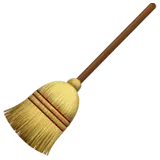 Cleaning
CleaningAs needed
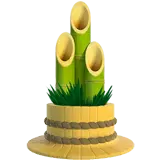 Soil
SoilWilliamsii camellias prefer slightly acidic soil with pH between 5.5 and 6.5. The best soil mix consists of a combination of 50% peat moss or coco coir, 30% pine bark, and 20% perlite to ensure good drainage and aeration.
 Repotting
RepottingWilliamsii camellias should be repotted every 2-3 years, best done in spring or after they have finished flowering to minimize stress.
 Humidity & Misting
Humidity & MistingWilliamsii camellias thrive in moderate to high humidity levels, ideally between 40% and 60%, as they are native to humid climates.
 Suitable locations
Suitable locationsIndoor
Place in bright, indirect light and keep consistently moist.
Outdoor
Plant in partial shade with shelter from strong winds and midday sun.
Hardiness zone
7-9 USDA
 Life cycle
Life cycleCamellia × williamsii 'Galaxie', commonly known as Williamsii Camellia, begins its life cycle when a seed germinates, usually in spring, after which a small seedling emerges. The seedling goes through a juvenile phase, where it focuses on producing leaves and roots, gradually maturing to form a small shrub. Over time, the shrub experiences vegetative growth, establishing a sturdy stem structure, glossy evergreen leaves, and a robust root system. After reaching maturity, which can take several years, it begins its reproductive phase, developing buds that will blossom into large, showy flowers typically in late winter or early spring. Once pollinated, usually by insects, the flowers produce seeds, completing the reproductive cycle. The shrub continues to grow and can produce flowers annually for many years, often requiring pruning to maintain shape and promote healthy growth.
 Propogation
PropogationPropogation time
Spring-Early Summer
The most popular method for propagating Camellia × williamsii 'Galaxie', commonly known as Williamsii Camellia, is through semi-hardwood cuttings. This is typically done in late summer when the current year's growth has started to firm up. You would take cuttings of about 4 to 6 inches (approximately 10 to 15 centimeters) in length, ensuring each cutting has several leaves. The cut end of the cutting is then dipped in rooting hormone to encourage root development and planted in a mixture of peat and perlite or a similar well-draining medium. It's important to maintain a humid environment for the cuttings, often by covering them with a plastic bag or placing them in a propagator, and keeping them in indirect light until they root, which can take several weeks. Once rooted, the cuttings can be potted up into individual containers.
